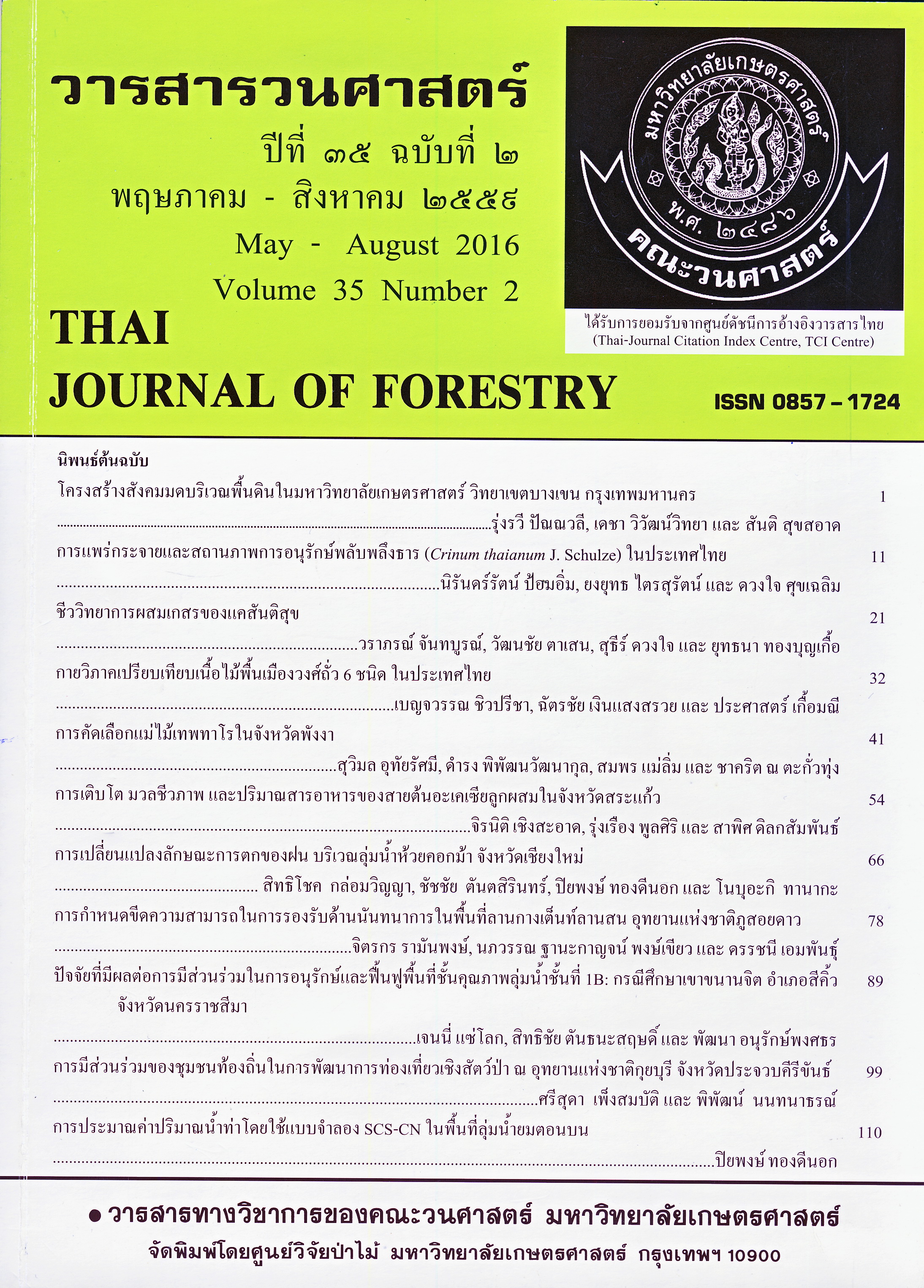ชีววิทยาการผสมเกสรของแคสันติสุข
Main Article Content
บทคัดย่อ
การศึกษาชีววิทยาการผสมเกสรของแคสันติสุข เก็บข้อมูลบริเวณวนอุทยานถ้ำเพชร-ถ้ำทอง จังหวัดนครสวรรค์ ตั้งแต่เดือนมกราคม พ.ศ. 2556 ถึง เดือนมีนาคม พ.ศ. 2558 โดยมีวัตถุประสงค์เพื่อศึกษาการพัฒนาของดอกและผล ระบบการผสมพันธุ์ การติดผลและค่าความสำเร็จการสืบพันธุ์ของแคสันติสุข จากการศึกษาพบว่าแคสันติสุขเริ่มออกดอกตั้งแต่ต้นเดือนมีนาคม การพัฒนาของดอกจะเกิดจากตาดอกจนถึงดอกบานใช้เวลาประมาณ 4 สัปดาห์ ดอกที่ไม่ได้รับการผสมหรือผสมไม่ติด จะร่วงไปภายในเวลา 3 สัปดาห์ ดอกย่อยเป็นดอกแบบสมบูรณ์เพศ ช่อดอกแบบช่อกระจุกแยกแขนง ดอกบานตั้งแต่เวลา 04.00 น. และจะบานเต็มมี่เวลา 07.00 น. เกสรต่างเพศในดอกเดียวกันแก่ไม่พร้อมกัน คือเกสรเพศผู้แก่ก่อนเกสรเพศเมีย (protendry) ช่วงเวลาที่ยอดเกสรเพศเมียพร้อมรับเรณู คือตั้งแต่หลังดอกบาน 3 ชั่วโมง แต่ไม่เกิน 12 ชั่วโมง ระยะเวลาการพัฒนาผลของแคสันติสุขตั้งแต่หลังดอกบานจนถึงผลสุกใช้เวลาประมาณ 9 สัปดาห์ โดยค่าเรณูต่อออวุล (P/O ratio) ของแคสันติสุขมีค่าเท่ากับ111.77 ± 0.20 ซึ่งจัดอยู่ในลักษณะการผสมข้ามต่ำกันมีแนวโน้มผสมพันธุ์ในตัวเอง (facultative autogamy) ส่วนการศึกษาการติดผลของแคสันติสุขพบติดผลเฉพาะในวิธีการใช้มือช่วยผสมแบบข้ามต้น (cross hand-pollination) และการผสมอบบเปิด (opened pollination) ทั้งนี้เมื่อวิเคราะห์ค่าความสำเร็จของการสืบพันธุ์พบว่ามีค่าต่ำ (0.013) แสดงให้เห็นว่าแคสันติสุขมีระบบผสมพันธุ์แบบผสมข้าม จัดเป็นพืชที่ต้องการพาหะช่วยในการผสมเกสร
Downloads
Article Details
ข้าพเจ้าและผู้เขียนร่วม (ถ้ามี) ขอรับรองว่า ต้นฉบับที่เสนอมานี้ยังไม่เคยได้รับการตีพิมพ์และไม่ได้อยู่ในระหว่างกระบวนการพิจารณาตีพิมพ์ลงในวารสารหรือสิ่งตีพิมพ์อื่นใด ข้าพเจ้าและผู้เขียนร่วม (ถ้ามี) ยอมรับหลักเกณฑ์และเงื่อนไขการพิจารณาต้นฉบับ ทั้งยินยอมให้กองบรรณาธิการมีสิทธิ์พิจารณาและตรวจแก้ต้นฉบับได้ตามที่เห็นสมควร พร้อมนี้ขอมอบลิขสิทธิ์ผลงานที่ได้รับการตีพิมพ์ให้แก่วารสารวนศาสตร์ คณะวนศาสตร์ มหาวิทยาลัยเกษตรศาสตร์ กรณีมีการฟ้องร้องเรื่องการละเมิดลิขสิทธิ์เกี่ยวกับภาพ กราฟ ข้อความส่วนใดส่วนหนึ่ง หรือ ข้อคิดเห็นที่ปรากฏในผลงาน ให้เป็นความรับผิดชอบของข้าพเจ้าและผู้เขียนร่วม (ถ้ามี) แต่เพียงฝ่ายเดียว และหากข้าพเจ้าและผู้เขียนร่วม (ถ้ามี) ประสงค์ถอนบทความในระหว่างกระบวนการพิจารณาของทางวารสาร ข้าพเจ้าและผู้เขียนร่วม (ถ้ามี) ยินดีรับผิดชอบค่าใช้จ่ายทั้งหมดที่เกิดขึ้นในกระบวนการพิจารณาบทความนั้น”
เอกสารอ้างอิง
Almeida-Soares, S., L.P. Polatto, J.C.S. Dutra and H.M. Torezan-Silingardi. 2010. Ecological, Behavior and BionomicsPollination of Adenocalymma bracteatum (Bignoniaceae): Floral Biology and Visitors. Neotropical Entomology 39 (6): 941-948.
Bittencourt, N.S. Jr. and J. Semir. 2004. Pollination biology and breeding system of Zeyheria montana (Bignoniaceae). Plant Systematics and Evolution 247: 241-254.
Cruden, R.W. 1997. Pollen-ovule ratio: a conservative indicator of breeding systems in flowering plants. Evolution 31: 32-46.
Cruden, R.W. 2000. Pollen grain: why so many?. Plant Systematics and Evolution 222: 143-165.
Cruden, R.W. and D.L. Lyon. 1985. Correlations Among Stigma Depth, Style Length, and Pollen Grain Size: Do They Reflect Function or Phylogeny?. Botanical Gazette 146: 143-149.
Gentry, A.H. 1974. Flowering Phenology and Diversity in Tropical Bignoniaceae. Biotropica. 6 (1): 64-68.
Konar, R.N. and H.F. Linskens. 1966. Physiology and Biochemistry of the stigmatic fluid of Petunia hybrid. Planta (Berl.) 71: 372-387.
Ruksat, L. 1991. Pollen grain. Odian Store, Bangkok. (in Thai)
Saensouk, P. and S. Saensouk. 2011. Palynology of Some Bignoniaceae Species in Northeastern Thailand. KKU Research Journal 16 (2): 187-195. (in Thai)
Santisuk, T. 1987. Bignoniaceae, pp 32-66. In T. Smitinand and K. Larsen (eds.), Flora of Thailand Vol 5 part 1. Chutimapress, Bangkok.
Sornsathapornkul, P. 1999. Sexual Reproductive potential of Acacia hybrid. Silvicultural Research Division, Royal Forest Department, Bangkok. (in Thai)
Somanathan, H. and R.M. Borges. 2001. Nocturnal Pollination by the Carpenter Bee Xylocopa tenuiscapa (Apidae) and the effect of Floral Display on Fruit Set of Heterophragma quadriloculare (Bignoniaceae) in India. Biotropica 33 (1): 78-89.
Srithongchuay, T., Sripao-raya, E. and S. Bumrungsri, 2008. The pollination ecology of the late-successional tree, Oroxylum indicum (Bignoniaceae) in Thailand. Journal of Tropical Ecology 24 (5): 477-484.
Tangmitcharoen, S. and J.N. Owens. 1997. Floral biology, pollination, pistil receptitive, and pollen-tube growth of teak (Tectona grandis L.f.). Annals of Botany 79: 227-241.
Tangmitcharoen, S., P. Yongrattana, V. Luangviriyasaeng, W. Tasen, P. Chanthep and S. Saengtubtim. 2008. Floral Biology of Aquilaria crassna Pierre ex Lecomte. Thai Journal of Forestry 27 (2): 1-13. (in Thai)
Tasen, W. 2001. The Role of Some Major Insect Pollinators on Pollination of Teak (Tectona grandis Linn.f.) M.S. Thesis, Kasetsart University. (in Thai)
The Plant List. 2013. Santisukia. Available Source: http://www.theplantlist.org/1.1/browse/A/Bignoniaceae/Santisukia, August 16, 2014.
Vesek, F.C. and V. Weng. 1988. Breeding Systems of Clarkia sect. Phaeostoma (Onagraceae): I. Pollen-Ovule ratios. Systematic Botany 13: 336-350.
Urcelay, C., C.L. Morales and V.R. Chalcoff. 2006. Relationship between corolla length and floral larceny in the South American hummingbird-pollinated Campsidium valdivianum (Bignoniaceae). Annales Botanici Fennici 43: 205-211.
Webb, C.J. 1994. Pollination, self-incompatibility and fruit production in Corokia cotoneaster (Escallohiaceae). New Zealand Journal of Botany 32: 385-392.
Wiens, K., C.L. Calvin, C.A. Wilson, C.I. Cavem, D. Frank and S.R. Seavey. 1987. Reproductive success, spontaneous embryo abortion and genetic load in flowering plants. Oecologia 71: 501-509.


